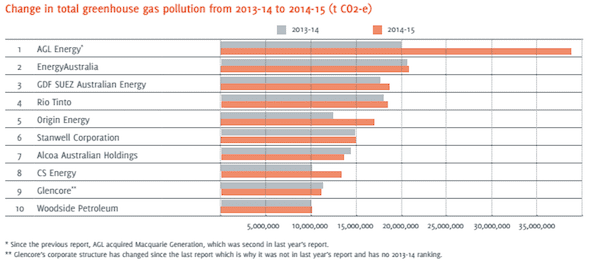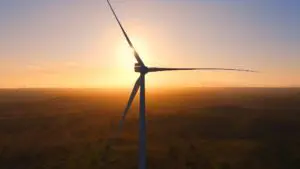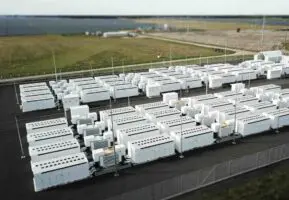New government data has confirmed what has been widely suspected – the nation’s top polluters are actually increasing emissions, and will likely continue to do so despite Australia’s recent pledge to join the ambitious climate agreement sealed in Paris.
The National Greenhouse and Energy Report released late on Friday reveals the nation’s top 10 polluters – and AGL again takes top spot, this time reinforcing its position with the multi-billion dollar purchase of large coal fired generators in NSW.
The data, and an analysis from the Australian Conservation Foundation, confirm that in the same year that Australia signed up to the historic Paris climate deal – an agreement to actively pursue efforts to limit global warming to 1.5°C above pre-industrial levels – the nation’s carbon pollution levels increased, as the country’s electricity generation sector became even more reliant on coal power.
The ACF report finds that despite the federal government’s assurances that its climate policies are working, the amount of climate pollution being emitted is rising – the vast majority of which comes from burning black and brown coal to generate electricity.
“Energy companies in the 10 biggest climate polluters list are responsible for the equivalent of 22 per cent of Australia’s climate pollution,” says the report, and nearly all through scope 1 emissions (scope 1 emissions are those that result directly from an activity at a facility (or machine) owned by a company. Scope 2 emissions come from the consumption of electricity produced at another facility).

Using the latest National Greenhouse & Energy Reporting Scheme data, the report shows that all but two of these 10 companies polluted more in the last year than in the previous one; a trend led by AGL Energy which, as you can see the in table and chart below, effectively doubled its emissions (yoy) in 2014-15, despite its well publicised efforts at a green energy makeover.


The report attributes AGL’s “dramatic” increase in emissions in 2015 – nearly double that of number two on the list, Energy Australia – to its acquisition of Macquarie Generation’s Bayswater and Liddell power stations in that year.
Origin Energy, meanwhile, jumped three spots to number five as a result of increased production at its Eraring coal-fired power station, which it bought from the NSW government in 2015, and which increased production by 43 per cent over 2014-15, pushing up its emissions by four million tonnes.
“If you listen to the federal government you’d be forgiven for thinking Australia’s pollution levels were decreasing, when in fact Australia’s pollution increased by 1.3 per cent in 2014-15 – that’s 7,200,000 additional tonnes of planet warming pollution pumped into our skies in just one year,” said ACF President Geoff Cousins in a statement on Monday.
And this is happening, cousins notes in the report’s introduction, due to the climate policy vacuum created when former PM Tony Abbott made the axing of Australia’s world-leading carbon price his first order of business, back in 2013.
“In axing the carbon price, the government removed the one policy Australia had to reduce climate pollution from the energy sector, leaving electricity generators – and the rest of us – largely reliant on coal for our power,” Cousins writes.
“Australia’s energy sector is crying out for federal government leadership to help the industry make the transition to a zero-pollution future.
Instead, he adds, “(Coalition) policies encourage them to keep doing what they’ve been doing for decades.
“The big polluters identified in this report own some of the world’s dirtiest coal-fired power stations,” says Cousins – and you can see a list of those below. “Every day these dirty power stations are spewing out pollution. Every day they are making climate change worse,” he says.

“While the …Emissions Reduction Fund gives taxpayers’ money to Wesfarmers, the owner of Coles, Kmart and Bunnings, to install efficient lighting, the big polluters continue to pollute freely.
“As a result, Australia’s emissions intensity from generating power is higher than China’s and twice the emissions intensity of other OECD countries.”
Cousins closes his comments by urging the federal government to commit to a phased closure of Australia’s coal-fired power stations, starting with the dirtiest and least efficient stations – as you can see in the chart above, this would be the Victorian brown coal plant Hazelwood owned by GDF Suez (Engie), which also owns Loy Yang A and B.
“It’s time for Australia to get out of last century’s energy sources and leap into a brighter future powered by clean energy,” he says.








